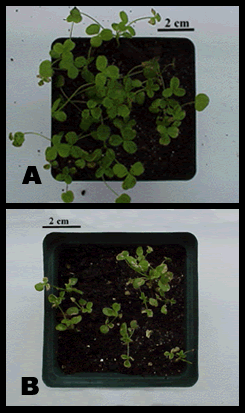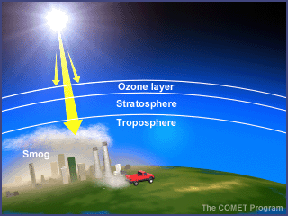
Greg Anderson, Bates College, Department of Biology
Air Pollution Affects Plants, Animals, and Environments
Some air pollutants harm plants and animals directly. Other pollutants harm the habitat, food or water that plants and animals need to survive. Read on to learn more about how air pollutants harm plants and animals.
Acid rain harms living things
When acidic air pollutants combine with water droplets in clouds, the water becomes acidic. When those droplets fall to the ground, the acid rain can damage the environment. Damage due to acid rain kills trees and harms animals, fish, and other wildlife. Acid rain can destroy the leaves of plants like in the picture at the left. When acid rain soaks into the ground, it can make the soil an unfit habitat for many living things. Acid rain also changes the chemistry of the water in lakes and streams, harming fish and other aquatic life.
The thinning ozone layer harms living things
Air pollutants called chlorofluorocarbons(or CFCs) have destroyed parts of the ozone layer.The ozone layer, located in the stratosphere layer of Earth's atmosphere, shields our planet from the Sun's ultraviolet radiation. The areas of thin ozone are called ozone holes. Ultraviolet radiation causes skin cancer and damages plants and wildlife.
Tropospheric ozone harms living things
Ozone molecules wind up near the Earth's surface as a part of air pollution. Ozone molecules near the ground damages lung tissues of animals and prevent plant respiration by blocking the openings in leaves where respiration occurs. Without respiration, a plant is not able to photosynthesize at a high rate and so it will not be able to grow.
Global warming harms living things
Our planet is currently warming much more rapidly than expected because additional greenhouse gases are being released into the atmosphere from air pollution. When fuels are burned, some of the pollutants released are greenhouses gases. Through the process of photosynthesis, plants convert carbon dioxide into oxygen and use the carbon to grow larger. However, the amount of carbon dioxide released by burning fuels is much more than plants can convert.
Global warming is causing changes to the places where plants and animals live around the world. For example:
- Near the poles, ice and frozen ground are melting. This causes changes in the habitat and resources for plants and animals living there.
- Ocean warming, rising sea levels, runoff, and coral diseases are causing change in shallow marine environments such as coral reefs.
- Global warming is causing less rain to fall in the middle of continents. This makes these areas very dry and limits water resources for plants and animals.














